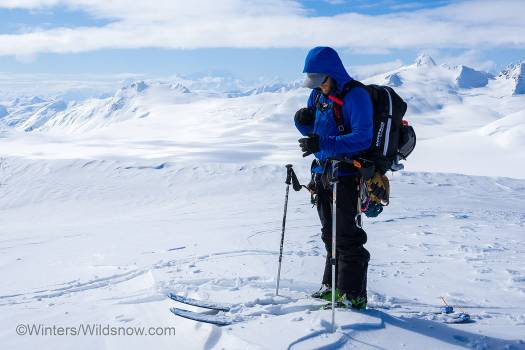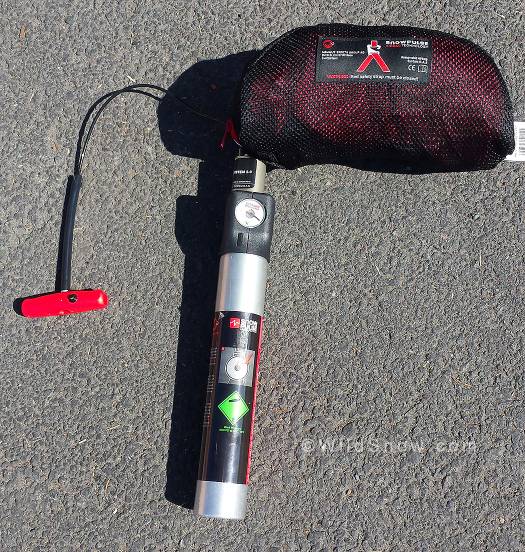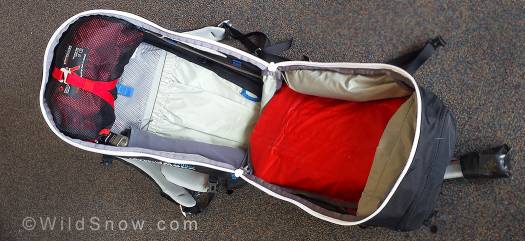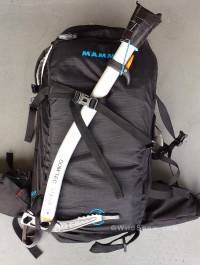Jason Davis

I was able to strap a rope to the outside of the pack without covering up the airbag zipper using a ski strap. Click to enlarge.
The popularity of airbag packs is growing exponentially and for good reason. Research and survivor testimony suggest they provide a greater chance of survival in the event you are caught in an avalanche. Losing a good friend in a slide last year was the catalyst for me to start using an airbag.
This winter I’ve been testing out the Mammut Removable Airbag System (RAS) Pro Short 33L and have found it to be a versatile and functional ski pack. My requirements for any pack are that it needs to fit and carry well. I also prefer a shorter pack that doesn’t interfere with my helmet, even while riding a snowmobile.
I’m 5’8” tall with a 17” long torso (iliac crest to C7). There aren’t too many airbag packs that fit me, carry well and also have enough volume to hold everything I like to bring for a longer tour. The RAS Pro Short fits me well and carries better than most ski packs that I’ve used. It sports an internal frame, solid hipbelt and comfortable padding. If you’re any taller than me I’d recommend trying out the bigger RAS Pro instead. As with all packs, try to find a local shop to see how they feel and fit when loaded.
The RAS Pro has two compression straps on each side that are sewn into reinforced seams and can be used as an A-Frame ski carry. Carrying skis this way will definitely interfere with the airbag, but it is nice to have that option for approach hikes or conditions when the airbag isn’t warranted.
The Removable Airbag System is easy to remove from the pack and it took me about fifteen minutes to switch it over from a smaller 28L Mammut Ride Short pack. This gives you the option of having a quiver of Mammut RAS packs without buying more than one airbag system if you want to go that route. In my opinion the Pro Short compresses well enough that having a separate, smaller pack for inbounds riding would be excessive. More importantly, it allows you to drop weight and gain about 3 liters of volume (bringing you up to the advertised 33 liters) when the airbag system isn’t needed.
For the record, I’m a fan of packs that have certain features that might be absent on more lightweight packs. The Pro Short definitely falls into the feature-heavy category. The pack has a main compartment, a small fleece lined goggle pouch and a separate avi-tool pocket. The main compartment can be accessed by both a zip-away back panel and the main zipper, which allows you to completely open the pack clamshell-style. This is nice because you can access either side of the main compartment through the zipper, without completely opening the pack up. The downside of this configuration is the added weight of a long reinforced zipper and the potential for the main zipper to fail.
I definitely stuffed the pack full every day we skied on Glacier Bay, and needed to strap the rope on the outside when we weren’t using it.
The avalanche tool pocket is big and I was able to stuff my fairly large shovel and 300cm probe in, along with ascent plates and crampons. I found this to be convenient on my recent trip to Haines because I didn’t have to dig through the pack on the side of a face while transitioning from skinning to booting. Yard sales aren’t as much fun on the climb up.
There is a diagonal ski carry and vertical snowboard carry that are both compatible with the airbag deployment. The straps are reinforced directly onto the seam next to the compression straps, so when everything is cinched down, the load sits securely and doesn’t flop around.
The ski carry straps have little sleeves that you can tuck them through so there aren’t extra straps flopping around. Alternatively, if you’re never going to use the snowboard carry, you could just cut them off and replace the top strap with a ski strap through the sleeve. The axe carry uses the same strap with a standard flip-over loop at the bottom. Part way through our Alaska trip, I realized that the axe shaft pick was worryingly close to where the airbag deploys. I made a little pick cover to remedy the situation.
Nothing is perfect and I do think there is room for improvement with this pack. The removable airbag system works by puncturing a small metal disk seated under a flange which is on top of the compressed air cylinder. It’s a simple system that is fairly lightweight and has worked reliably the handful of times I’ve deployed it to test or travel. To re-arm the system, you need to replace the disk and washer (Mammut sells refill kits). My problem with the system is that in order to fly with the pack in the U.S., it’s recommended that you remove the entire valve from the cylinder so that a security agent can see that the cylinder is empty. You’ll need a strap wrench and a large adjustable wrench to remove the valve and a torque wrench to tighten it to the right spec. The cylinder comes with all of the instructions and torque specs, which can also be found on Mammut’s website here. Don’t try to just hand tighten it or you, too, could be left scrambling to get the cylinder refilled in Haines at the last minute. I spoke to a TSA agent in the Juneau airport who was familiar with airbag packs and while he said that he had allowed the Mammut/Snowpulse cylinder through with just the disk removed, I wouldn’t recommend risking it. So while this system is light, if you’re flying somewhere without a shop equipped with the necessary tools, be prepared with your own. It’s clear that a battery powered fan system will always be superior for air travel, but compressed gas systems are much lighter for now.
On a more minor note, the helmet carry is a little finicky and I think the main clamshell zipper could be removed entirely to shave some weight and remove a potential failure point as the back panel provides plenty of access to the main compartment on its own.
In general, the build quality of the pack is excellent, and it shows a Swiss-level of attention to detail. Almost all of the little things are well thought out and it’s clear Mammut has designed this pack to stand up to heavy use. The zipper tabs are solid and easy to pull even with gloves on. The buckles, zippers, straps and fabric are sturdy and it’s clear that Mammut didn’t cut any corners with the materials. There are lots of well thought out design choices like a hydration bladder sleeve next to your back so your body heat keeps it warm. The pack has endured a season’s worth of my abuse and I expect it to last for a long time. For me, the RAS Pro Short hits a sweet spot in volume, features and fit. This is a well designed ski pack with or without the RAS and it should be on your radar if you’re looking at new airbag packs.
(Guest blogger Jason Davis is a climber, kayaker and skier living in the Pacific North Wet. He works as a sea kayak guide for Discovery Sea Kayaks on San Juan Island, WA during the warmer months and searches for good views, aesthetic lines and soft snow while attempting to work as little as possible during the winter. His other hobbies include spaghetti western card games and enjoying vigorous legal debates with polite Canadian Border guards.)
Shop for Mammut airbag packs here.
Beyond our regular guest bloggers who have their own profiles, some of our one-timers end up being categorized under this generic profile. Once they do a few posts, we build a category. In any case, we sure appreciate ALL the WildSnow guest bloggers!




